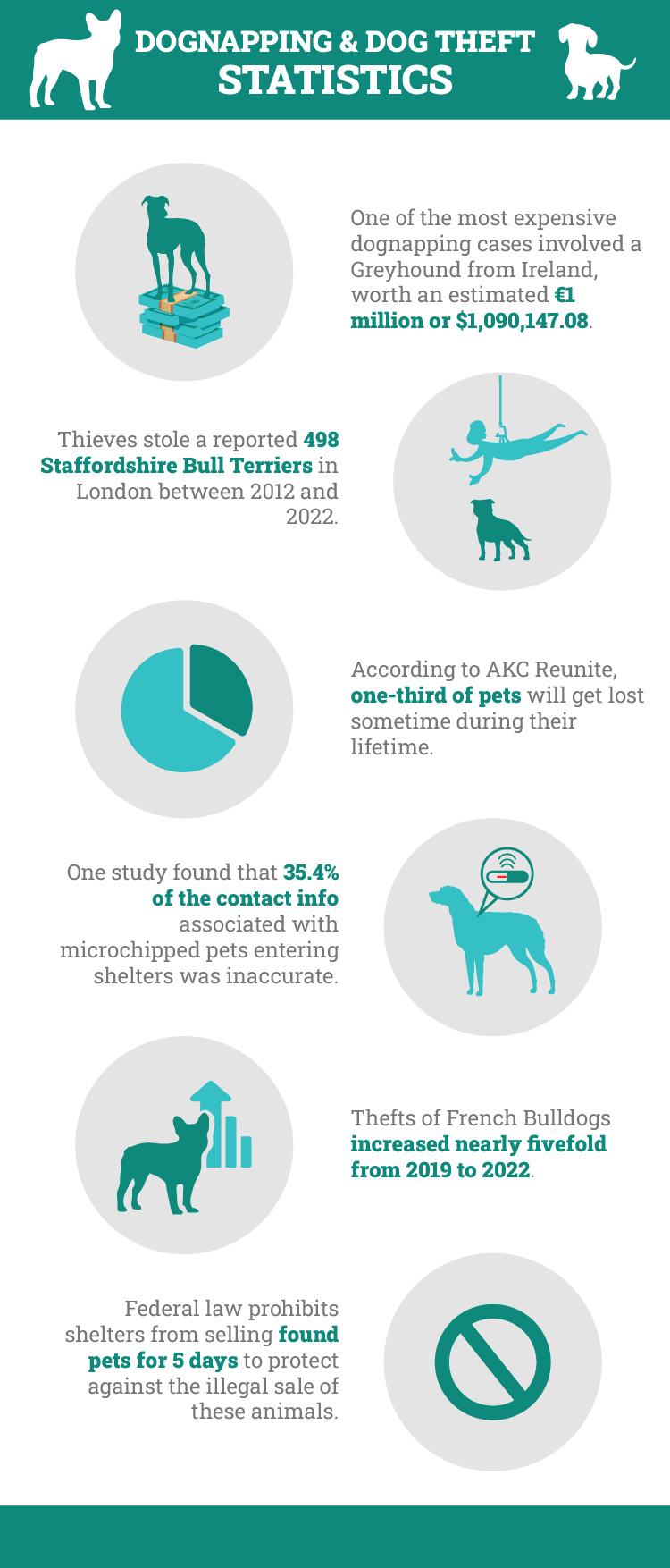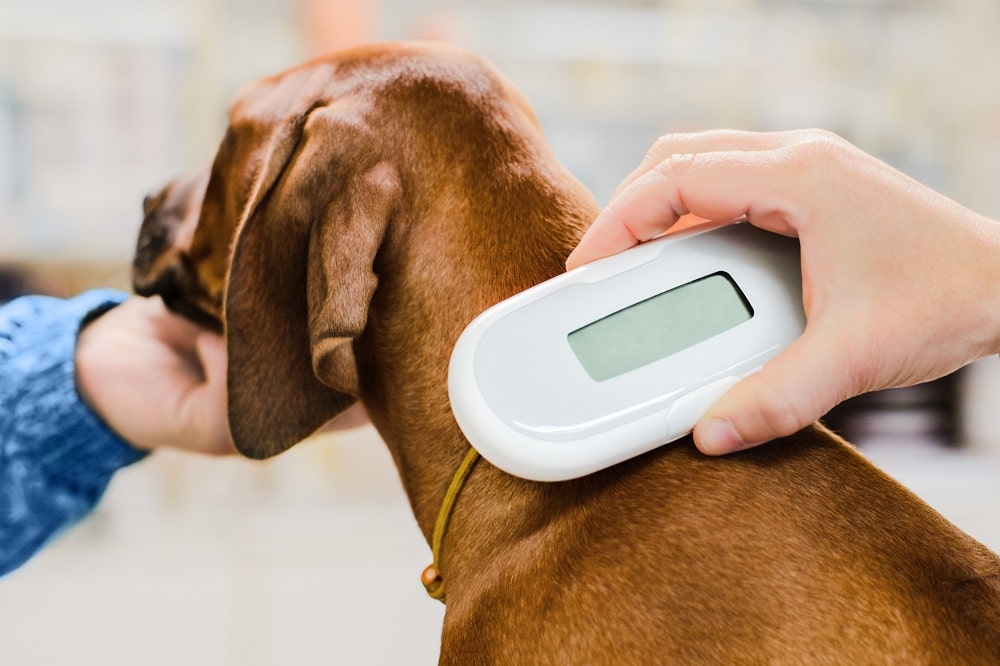Click to Skip Ahead
Note: This article’s statistics come from third-party sources and do not represent the opinions of this website.
It’s hard to imagine anything so devastating as losing a pet, let alone learning your dog was stolen. The act gives a new face to cruelty. After all, dogs form attachments to their owners, not unlike a baby and their caregiver. Separating a canine companion from their family can profoundly affect both the animals and humans.
Sadly, dognapping, where a dog is taken for ransom, and outright dog theft are not new crimes. Various motives exist, and money is often behind them. Fortunately, there are measures you can take to protect your beloved pet.
The 12 Dognapping & Dog Theft Statistics
- One of the most expensive dognapping cases involved a Greyhound from Ireland, worth an estimated €1 million or $1,090,147.08.
- Poet Elizabeth Barrett Browning risked her life to save her dog Flush after being dognapped for ransom three times.
- Thieves stole a reported 498 Staffordshire Bull Terriers in London between 2012 and 2022.
- According to AKC Reunite, one-third of pets will get lost sometime during their lifetime.
- Purebred dogs are a frequent target because of their value, with French Bulldogs fetching up to $12,000.
- One study found that 35.4% of the contact info associated with microchipped pets entering shelters was inaccurate.
- Thefts of French Bulldogs increased nearly fivefold from 2019 to 2022.
- Thefts have increased 140% in the last 4 years.
- Dog theft is an international crime, with a purported 75,000 pups stolen annually in France.
- Lost dogs average 2 days before being found.
- According to Michigan State University College of Law, 23 states limit tethering pets.
- Federal law prohibits shelters from selling found pets for 5 days to protect against the illegal sale of these animals.

The Scope of the Problem
1. One of the most expensive dognapping cases involved a Greyhound from Ireland, worth an estimated €1 million or $1,090,147.08.
(Irish Times)
This dog’s (named Clares Rocket) value was in their stud fees for what many considered one of the best racing canines. Three men brazenly stole the dog from the kennel and then tried to extort the owner for the animal’s return. Fortunately, police caught the thieves and returned the dog to their owner. We wish all cases had this happy ending, but that’s unfortunately not always the case.

2. Poet Elizabeth Barrett Browning risked her life to save her dog Flush after being dognapped for ransom three times.
(Psychology Today)
Dognapping was rampant during Victorian times. The thieves targeted the wealthy, demanding ransom for the stolen pets. Poet Elizabeth Barrett Browning was a victim three times. She purportedly went to a dangerous part of the city to negotiate the release of her beloved pup, despite the warnings from her family that she would be robbed or murdered. She cared little for her safety. However, the thief took pity on her and released her pet.
3. Thieves stole a reported 498 Staffordshire Bull Terriers in London between 2012 and 2022.
(Statista)
Thieves targeted the Staffordshire Bull Terrier more than any other breed during this time, accounting for roughly 26.6% of reported crimes. However, these figures only scratch the surface of the scope of the problem. The chances are the number is conservative, with many cases going unreported.

4. According to AKC Reunite, one-third of pets will get lost sometime during their lifetime.
(AKC Reunite)
It’s a sobering figure when you juxtapose it with the other statistics about recovery. It’s undoubtedly a wake-up call to all pet owners to keep their animal companions safe and accounted for to avoid adding their sad stories to these numbers.
5. Purebred dogs are a frequent target because of their value, with French Bulldogs fetching up to $12,000.
(Psychology Today)
Dog theft is a sophisticated racket worth big money. Purebred dogs are a frequent target, even if they get higher prices than breeders offer. A stolen dog means no pre-approval by sellers and the hassle that may entail, so stealing pets cuts to the chase. The French Bulldog is the American Kennel Club’s most popular breed, which explains the high price tag for a stolen animal.
Complications
6. One study found that 35.4% of the contact info associated with microchipped pets entering shelters was inaccurate.
(Journal of the American Veterinary Medical Association)
Many breeders and most shelters require microchipping for the animals they handle. It’s an excellent way to reunite pets and owners. However, as this figure shows, it only works well if the contact information is accurate. It’s imperative to keep your contact info updated. Many vet clinics routinely scan newly adopted pets to remind people to verify this information.

7. Thefts of French Bulldogs increased nearly fivefold from 2019 to 2022.
(Inside Edition)
Popularity comes at a price. French Bulldogs have recently risen in popularity. Unfortunately, that’s also made them a target for thieves. Reports of stolen dogs have increased nearly 500% from 2019 to 2022. The scenario has played out similarly for other favorite breeds. As Lady Gaga’s dog walker learned firsthand, crooks have no problem stealing animals, even in broad daylight.
8. Thefts have increased 140% in the last 4 years.
(Scripps News)
Many factors have conspired to increase dog thefts. They involve issues like a lack of awareness of the risks, cunning thieves, and money. The latter is a potent motivator. The thieves are more aggressive, and there are few laws to deter them. Complicating the issue are the many outlets, whether for so-called scientific research, dogfighting, or other unscrupulous venues.

9. Dog theft is an international crime, with a purported 75,000 pups stolen annually in France.
(Connexion France)
Dognapping and dog theft are global problems. An estimated 75,000 animals are stolen annually in France. The issue overseas is also profit-driven, complicated by a lack of robust legislation to protect the dogs. Similar trends exist with the targeted breeds and money exchanged. France takes these crimes seriously, with fines up to €45,000 (about $49,060) and up to 3-year jail terms. Yet, it continues to rise.
10. Lost dogs average 2 days before being found.
(Journal of the American Veterinary Medical Association)
While statistics show only 2 days, it can seem like a lifetime for a dog owner. Nevertheless, it speaks to the value of using multiple ways to locate your pet. Ads, walks around the neighborhood, and ID information are excellent ways to reunite people with their pets. Of course, time is of the essence. Reporting the theft and getting the word out offer the best options.
Prevention Measures
11. According to Michigan State University College of Law, 23 states limit tethering pets.
(Michigan State University College of Law)
Some people tether or chain their dogs outside if they don’t have fenced-in yards. We understand the dilemma, but walking your pup for exercise is a better option. It’s also a safety concern when it comes to dognapping and theft. These animals are more vulnerable to dognapping. Luckily, 23 states have seen the light and regulate this practice. It’s a preventable factor with nuisance pets.

12. Federal law prohibits shelters from selling found pets for 5 days to protect against the illegal sale of these animals.
(Michigan State University College of Law)
Unscrupulous people always try to stay one step ahead. Getting dogs from shelters is a sneaky way a thief can get a dog to flip and profit from the sale. The Pet Theft Prevention Act strives to prevent this practice by forcing these organizations to keep animals for at least 5 days. It can give sufficient time for owners to locate their pets with some extra breathing room.
Frequently Asked Questions About Dognapping & Dog Theft
What Retribution Can I Get if My Dog Is Stolen?
(Journal of Legal Philosophy)
According to US law, pets are chattels or movable property. That limits how much you can expect to get in retribution if your dog theft case goes to trial. We’re not denigrating your canine companion. We’re only saying you may not get a settlement for the emotional cost of losing your pup if it comes to that unfortunate conclusion.
Does Pet Insurance Cover Theft?
You may have some luck on this front. Some insurers may cover some costs with these losses. They may help you get the word out if your dog is missing or stolen. That can make the difference in whether you two are reunited. We suggest reviewing your policy for specific information about this coverage.

What Should I Do if My Pup Is Stolen?
You should contact law enforcement immediately if your pet is stolen. Unfortunately, other, more serious crimes are often associated with dog theft. We recommend contacting the local shelters, rescue groups, and veterinary clinics. Check the footage on your security cameras for any leads on the perp. Some thieves try to flip the animals for a quick buck. Therefore, scan the local ads to try to find them as well.
What Can I Do to Prevent My Dog From Being Stolen?
Leaving your pooch alone leaves the animal vulnerable to theft or dognapping. That includes your backyard and unlocked home or vehicle. The best advice we can offer is to microchip your dog. It provides permanent identification that can help you get your pet back to you ASAP. Some experts also recommend spaying or neutering your dog to prevent thieves from breeding your dog for profit.
 Conclusion
Conclusion
Dognapping and dog theft are serious crimes. Unfortunately, cases continue to rise despite stricter laws. It behooves pet owners to protect their animal companions with measures such as microchipping and spaying/neutering. Money drives the crime, making your actions to protect your pet vital. Caution is the name of the game, whether it’s supervising your pet or being alert to potential threats.
See Also:
- Disheartening Dognapping & Dog Theft Statistics in Canada
- Disheartening Australia Dognapping and Dog Theft Statistics
- National Lost Dog Awareness Day
Featured Image Credit: mgequivalents, Shutterstock











